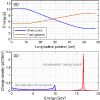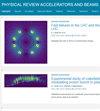FACET-II 氢和锂等离子体中的瓦基弗生成:诊断和首次光束-等离子体相互作用结果
IF 1.8
3区 物理与天体物理
Q3 PHYSICS, NUCLEAR
Physical Review Accelerators and Beams
Pub Date : 2024-05-24
DOI:10.1103/physrevaccelbeams.27.051302
引用次数: 0
摘要
等离子体汪场加速提供了数十 GeV/m 的超高加速梯度,为实现高效、紧凑、TeV 级线性对撞机和高亮度自由电子激光器提供了一条新途径。这些应用取得成功的关键在于同时展示高梯度加速、高能量传递效率以及保持发射率、电荷和能量扩散。位于 SLAC 国家加速器实验室的 FACET-II 国家用户设施的实验旨在通过单级等离子体唤醒场加速器实现所有这些里程碑式的目标,在具有高能量传递效率的 1 米等离子体中提供 10 GeV 的能量增益。这样的演示在很大程度上取决于能够测量毫米级精度辐照度的诊断技术、确定百分比级能量扩散的能谱、宽带能量增益和损耗、进入的纵向相空间以及匹配动力学。本文讨论了 FACET-II 的实验装置,包括来自 FACET-II 直列加速器的入射束参数、等离子源以及为应对这一挑战而开发的诊断方法。本文讨论了在米级氢气中产生束离子化湍流的初步进展,以及等离子体源和诊断仪的调试情况。本文章由计算机程序翻译,如有差异,请以英文原文为准。

Wakefield generation in hydrogen and lithium plasmas at FACET-II: Diagnostics and first beam-plasma interaction results
Plasma wakefield acceleration provides ultrahigh acceleration gradients of tens of GeV/m, providing a novel path toward efficient, compact, TeV-scale linear colliders, and high brightness free electron lasers. Critical to the success of these applications is demonstrating simultaneously high gradient acceleration, high energy transfer efficiency, and preservation of emittance, charge, and energy spread. Experiments at the FACET-II National User Facility at SLAC National Accelerator Laboratory aim to achieve all of these milestones in a single-stage plasma wakefield accelerator, providing a 10 GeV energy gain in a plasma with high energy transfer efficiency. Such a demonstration depends critically on diagnostics able to measure emittance with mm mrad accuracy, energy spectra to determine both percent level energy spread, and broadband energy gain and loss, incoming longitudinal phase space, and matching dynamics. This paper discusses the experimental setup at FACET-II, including the incoming beam parameters from the FACET-II linac, plasma sources, and diagnostics developed to meet this challenge. Initial progress on the generation of beam ionized wakes in meter-scale hydrogen gas is discussed as well as commissioning of the plasma sources and diagnostics.
求助全文
通过发布文献求助,成功后即可免费获取论文全文。
去求助
来源期刊

Physical Review Accelerators and Beams
Physics and Astronomy-Surfaces and Interfaces
CiteScore
3.90
自引率
23.50%
发文量
158
审稿时长
23 weeks
期刊介绍:
Physical Review Special Topics - Accelerators and Beams (PRST-AB) is a peer-reviewed, purely electronic journal, distributed without charge to readers and funded by sponsors from national and international laboratories and other partners. The articles are published by the American Physical Society under the terms of the Creative Commons Attribution 3.0 License.
It covers the full range of accelerator science and technology; subsystem and component technologies; beam dynamics; accelerator applications; and design, operation, and improvement of accelerators used in science and industry. This includes accelerators for high-energy and nuclear physics, synchrotron-radiation production, spallation neutron sources, medical therapy, and intense-beam applications.
 求助内容:
求助内容: 应助结果提醒方式:
应助结果提醒方式:


